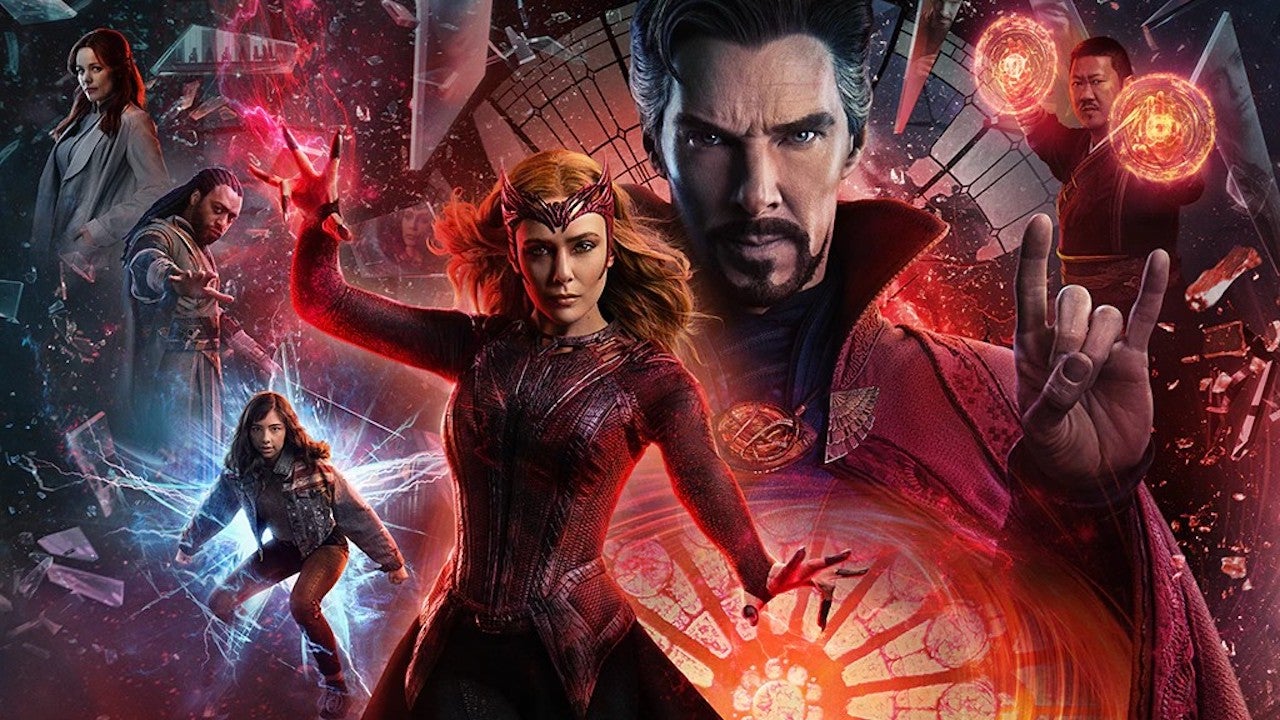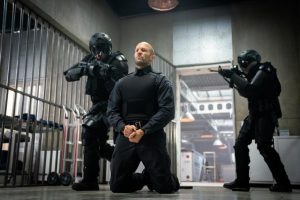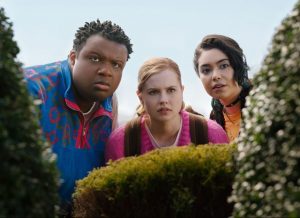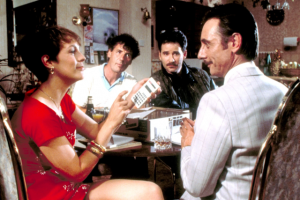
Not Quite What the Doctor Ordered.
The multitude of successes and failures of the larger MCU brand is put on full display with its most recent entry, Doctor Strange in the Multiverse of Madness. The film directed by Spider-Man and Evil Dead director Sam Raimi, more than any other Marvel effort to date, underscores issues of creative overlording (Kevin Feige, master of the box office, checking in) that has long plagued the comic book production house. The push and pull between actual directorial style and ownership of said style and the larger corporatized Marvel Brand has never been so readily apparent in the finished product, resulting in one of Marvel’s most split-identity entries to date. One that also houses some of its most daring and dazzling segments across all of its 28 films and six Disney+ TV events.
As a Marvel movie, Doctor Strange in the Multiverse of Madness is a bit of a mystic mess. Caught somewhere between tying up old story lines, introducing new major players, slipping in a handful of cameos (which exist anywhere on the spectrum between hilarious Raimi-world gags to pointless stunt casting to teasing the next big step forward for the ever-expanding franchise), and actually making a Doctor Strange movie, it has a lot to accomplish. Raimi’s film does each part of the job with varying levels of success, struggling to find its footing as a film forced to juggle so many disparate parts and accomplish so many different in-house corporate missions. But somewhere towards the middle of the mania, Doctor Strange in the Multiverse of Madness settles into being first and foremost a Sam Raimi film – and promptly begins to offer some of the most entertaining, wackadoo visions of the Marvel World thus far; a violent, lumbering, ghoulish joyride that actually delivers on the promise of “Marvel’s first horror movie”. At least in part.
 The film begins rather sluggishly as Doctor Steven Strange (Benedict Cumberbatch) and newcomer America Chavez (Xochitl Gomez) navigate the multiverse in search of The Book of the Vishanti, a powerful relic that can counter even the most wicked spells. Dark forces seek Chavez in the hopes of stripping her of her powers to jump between the many different realities of the multiverse so Strange, Sorcerer Supreme Wong (Benedict Wong), and the armies of Kamar-Taj align to protect the verse-jumping teen, mostly by slinging CGI spells at CGI monsters. For a movie that has a staggering amount of VFX post-production work, there’s some really badly rendered CGI, particularly in these early goings.
The film begins rather sluggishly as Doctor Steven Strange (Benedict Cumberbatch) and newcomer America Chavez (Xochitl Gomez) navigate the multiverse in search of The Book of the Vishanti, a powerful relic that can counter even the most wicked spells. Dark forces seek Chavez in the hopes of stripping her of her powers to jump between the many different realities of the multiverse so Strange, Sorcerer Supreme Wong (Benedict Wong), and the armies of Kamar-Taj align to protect the verse-jumping teen, mostly by slinging CGI spells at CGI monsters. For a movie that has a staggering amount of VFX post-production work, there’s some really badly rendered CGI, particularly in these early goings.
[READ MORE: Our review of ‘Spider-Man: No Way Home’ starring Benedict Cumberbatch and Tom Holland]
The set-up is nothing short of frighteningly bad. While Wanda Maximoff’s (Elizabeth Olsen) newfound role as the Scarlet Witch begins to take shape, the film buckles under its time constraints, fast-forwarding the character’s storyline to places that track only in the most broad of sense. It’s helpful, nay essential, to have seen WandaVision but even that installment just adds a layer of confusion regarding what Feige and Co’s plan for Wanda Maximoff was supposed to be. Olsen is great in the role that both underwritten and incredibly entertaining.
 Once Strange and Chavez finally enter the titular multiverse of madness, Raimi’s talents take hold and don’t get go for an instant. His directorial style is deeply felt in scenes that call back to his horror heyday, complete with dolly zooms, sidewinding cameras peering through creaking doors, wild kaleidoscopic visuals, choppy practical effects, and murderous rampages down dark hallways. There’s a point in Doctor Strange in the Multiverse of Madness where the movie begins to function as a supernatural slasher and it’s in these moments that Raimi’s film is at its most fun. It just makes sense that the man who once brought the Necronomicon to life with such go-for-broke style is also responsible for unleashing the MCU’s most sinister power: the Darkhold, a book of dark magic that curses its reader, allows wizards and witches to cast their consciousness across realities, and can even bring the dead back to the land of the living. A host of zombies, ghosts, and demons suddenly enter the reality of Marvel’s world and Raimi proves more than capable of making it fit even if the film is never really “scary”.
Once Strange and Chavez finally enter the titular multiverse of madness, Raimi’s talents take hold and don’t get go for an instant. His directorial style is deeply felt in scenes that call back to his horror heyday, complete with dolly zooms, sidewinding cameras peering through creaking doors, wild kaleidoscopic visuals, choppy practical effects, and murderous rampages down dark hallways. There’s a point in Doctor Strange in the Multiverse of Madness where the movie begins to function as a supernatural slasher and it’s in these moments that Raimi’s film is at its most fun. It just makes sense that the man who once brought the Necronomicon to life with such go-for-broke style is also responsible for unleashing the MCU’s most sinister power: the Darkhold, a book of dark magic that curses its reader, allows wizards and witches to cast their consciousness across realities, and can even bring the dead back to the land of the living. A host of zombies, ghosts, and demons suddenly enter the reality of Marvel’s world and Raimi proves more than capable of making it fit even if the film is never really “scary”.
[READ MORE: Our review of 2016’s ‘Doctor Strange’ directed by Scott Derrickson]
For a movie ostensibly about keeping too firm a grasp on control and the hubris of thinking that only you know best, Doctor Strange in the Multiverse of Madness sees that battle play out between its creators. Feige for so long has held such fierce control over every microcosm of this universe that he’s created, often to the dearth of actual directorial style shining through, that a great number of talented creators have left due to “creative differences”. An army more have seen their style trampled and stamped under the Marvel brand. That Feige and the House of Mouse actually lets Sam Raimi be Sam Raimi (at least for a portion of the movie) is a wonder, and perhaps signs of great things to come for the culture-eating juggernaut that is the Marvel Cinematic Universe. But then you remember all the other cluttered, clunky things about Doctor Strange in the Multiverse of Madness and can only hope the spell holds.
CONCLUSION: ‘Doctor Strange in the Multiverse of Madness’ is a tale of a corporate identity crisis; the punchline to what happens when a mediocre Marvel movie and a rip-roaring Sam Raimi joint walk into a bar. It contains some of the very best and very worst material in the whole MCU. But it’s a wild ride.
B-
For other reviews, interviews, and featured articles, be sure to:
Follow Silver Screen Riot on Facebook
Follow Silver Screen Riot on Twitter
The post When Sam Raimi Lets Loose, ‘DOCTOR STRANGE IN THE MULTIVERSE OF MADNESS’ Is Pure Dark Magic. Otherwise, Meh. appeared first on Silver Screen Riot.


